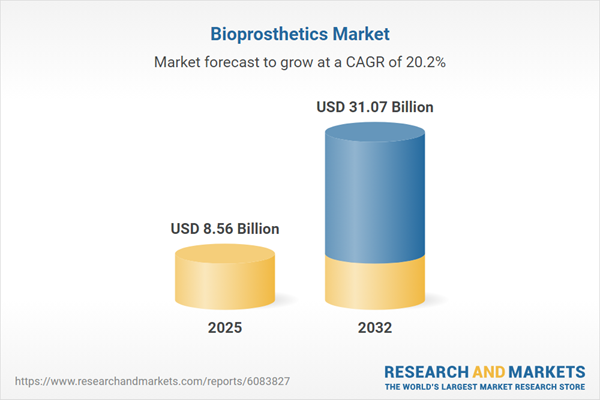Speak directly to the analyst to clarify any post sales queries you may have.
As the bioprosthetics market evolves, healthcare organizations and industry leaders are prioritizing biologically derived devices to address growing complexity in clinical practice. Continued advances in bioengineering and regulatory dynamics are shaping both product innovation and operational strategies, with significant implications for senior decision-makers responsible for long-term growth and market competitiveness.
Market Snapshot: Bioprosthetics Market Size and Growth Outlook
The global bioprosthetics market expanded from USD 7.14 billion in 2024 to USD 8.56 billion in 2025 and is projected to achieve a compound annual growth rate of 20.17%, reaching USD 31.07 billion by 2032.
Growth is primarily driven by ongoing innovation in tissue engineering, heightened demand for safer implant solutions, and broadened use across cardiovascular, orthopedic, dental, ophthalmic, and dermatological treatment areas. Senior executives navigate shifting supply chains, rapid technology evolution, and changes in global regulatory frameworks—all of which impact regional market opportunities and risk management.Scope & Segmentation: Diversified Applications and Stakeholder Value
- Product Types: Cardiovascular grafts, dental prostheses, dermal substitutes, heart valve prostheses, ophthalmic prostheses, orthopedic prostheses. Each category’s role is expanding, particularly in minimally invasive and complex procedures where clinical outcomes are closely tied to device performance.
- Material Types: Biological materials such as allografts and xenografts, alongside synthetic options including ceramics, metals, and polymers. This diversity supports tailored solutions for various therapeutic needs and patient profiles.
- Applications: Cardiovascular procedures (including heart valve replacement and vascular bypass), dental restoration, burn and wound healing, cataract surgery, retinal prosthesis, and joint replacements for the hip, knee, and shoulder. The broad application spectrum enables product differentiation in both established and emerging clinical segments.
- End Users: Ambulatory surgical centers, dental clinics, hospitals, and specialty clinics focusing on dermatology and ocular services. These end-user groups set unique requirements for procurement and device integration, influencing channel strategies across regions.
- Geographies: Americas (with coverage for North America and Latin America), Europe, the Middle East, Africa, and Asia-Pacific, including detailed analysis at country and sub-region levels. Regional dynamics inform both regulatory navigation and tailored commercialization approaches to fit local healthcare environments.
- Key Technologies: Scaffold design, decellularization, bioresorbable polymers, three-dimensional manufacturing, additive manufacturing, and bioelectronic integration. Technological advancements are pivotal in extending device lifespan, minimizing immune response, and enabling customized device designs.
- Competitive Coverage: Profiles and latest developments from major industry leaders, including Edwards Lifesciences, Medtronic, Abbott Laboratories, Boston Scientific, LivaNova, CryoLife, Terumo, W. L. Gore & Associates, Braile Biomedica, and Nipro. Benchmarking against these players enables informed investment and collaboration decisions.
Key Takeaways: Strategic Insights for Senior Leaders
- Innovations in biocompatible materials are driving the development of implants that closely mimic native tissue, which enhances patient outcomes and broadens clinical use cases.
- Cross-sector collaboration between medical device providers, research institutions, and digital health companies accelerates product pipeline development and facilitates the launch of next-generation, patient-specific solutions.
- Manufacturers are addressing cost fluctuation and supply uncertainty through supply chain localization, diversified sourcing, and vertical integration strategies to support uninterrupted operations.
- Deployment of digital monitoring and bioelectronic functionalities is improving real-time tracking of implant performance, reducing procedural complications, and supporting robust patient follow-up systems.
- Comprehensive segmentation analysis enables organizations to develop region-specific commercialization plans, fully considering healthcare infrastructure, clinical practices, and regulatory standards in target markets.
Tariff Impact: Policy-Driven Operational Shifts
New United States tariffs on imported biological and synthetic materials are forcing bioprosthetic manufacturers to realign supply chains and shift toward local production capabilities. These policy adjustments fuel research into domestic allograft solutions and expedite regulatory review of locally sourced materials. The resulting operational changes are fostering a more resilient, geographically distributed production landscape aimed at controlling costs and securing reliable inventory levels.
Methodology & Data Sources
This report leverages a rigorous research process that integrates secondary data from peer-reviewed sources, patent and regulatory databases, and clinical trial registries. Qualitative insights are obtained through interviews with industry executives and clinical thought leaders. Data reliability is ensured using advanced modeling and triangulation, providing senior leaders in the bioprosthetics market with actionable, strategic insights.
Why This Report Matters
- Delivers comprehensive analysis of current market innovations, strategic segmentation, and evolving regional opportunities essential for B2B stakeholders navigating the bioprosthetics sector.
- Equips decision-makers to manage complex challenges, including cost pressures, rapid technology adaptation, and compliance with changing regulations worldwide.
- Supports development of tailored strategies addressing market entry, partnership optimization, and operational resilience for sustained growth across diverse healthcare settings.
Conclusion
This report equips senior leaders with critical frameworks for understanding market drivers, adapting operational models, and advancing technology strategies. It provides a reliable foundation for informed decision-making and competitive positioning in bioprosthetics.
Table of Contents
3. Executive Summary
4. Market Overview
7. Cumulative Impact of Artificial Intelligence 2025
Companies Mentioned
The companies profiled in this Bioprosthetics market report include:- Edwards Lifesciences Corporation
- Medtronic PLC
- Abbott Laboratories
- Boston Scientific Corporation
- LivaNova PLC
- CryoLife, Inc.
- Terumo Corporation
- W. L. Gore & Associates, Inc.
- Braile Biomedica Produtos Cirurgicos S.A.
- Nipro Corporation
Table Information
| Report Attribute | Details |
|---|---|
| No. of Pages | 193 |
| Published | November 2025 |
| Forecast Period | 2025 - 2032 |
| Estimated Market Value ( USD | $ 8.56 Billion |
| Forecasted Market Value ( USD | $ 31.07 Billion |
| Compound Annual Growth Rate | 20.1% |
| Regions Covered | Global |
| No. of Companies Mentioned | 11 |









